Sony SDM-S81, SDM-S51, SDM-S71 User Manual

4-087-260-13(1)
TFT LCD Color
Computer Display
Operating Instructions |
|
|
GB |
|||
|
|
|
||||
|
|
|
|
|
|
|
Mode d’emploi |
|
|
|
|
|
FR |
|
|
|
|
|
||
|
|
|
|
|||
Bedienungsanleitung |
|
|
|
DE |
||
|
|
|
||||
|
|
|
||||
Manual de instrucciones |
|
ES |
||||
|
|
|||||
|
|
|
||||
Istruzioni per l’uso |
|
|
|
|
IT |
|
|
|
|||||
SDM-S51
SDM-S71
SDM-S81
© 2001 Sony Corporation
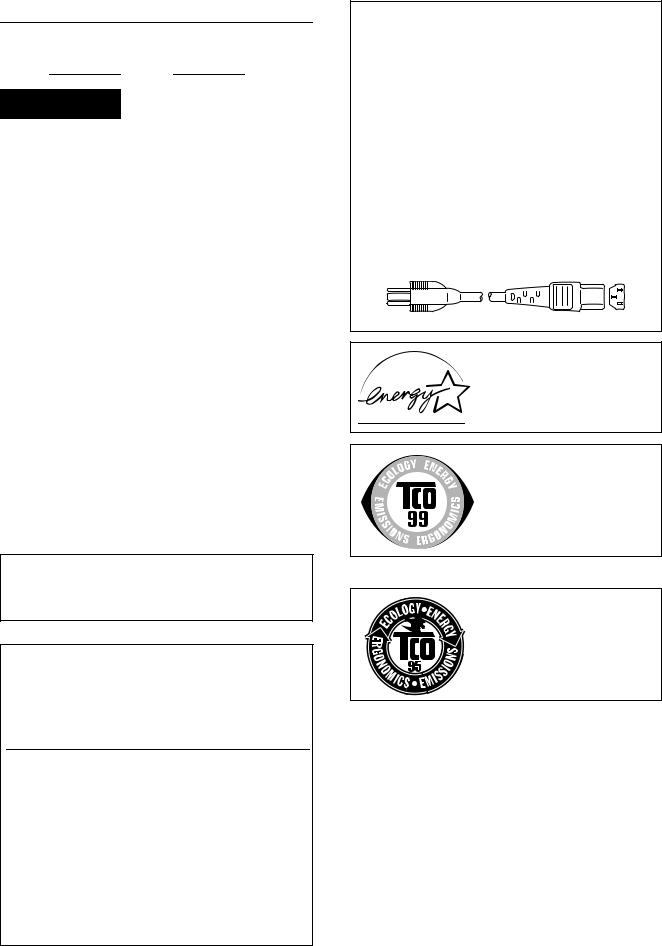
Owner’s Record
The model and serial numbers are located at the rear of the unit. Record these numbers in the spaces provided below. Refer to them whenever you call upon your dealer regarding this product. Model No. Serial No.
WARNING
To prevent fire or shock hazard, do not expose the unit to rain or moisture.
Dangerously high voltages are present inside the unit. Do not open the cabinet. Refer servicing to qualified personnel only.
FCC Notice
This equipment has been tested and found to comply with the limits for a Class B digital device, pursuant to Part 15 of the FCC Rules. These limits are designed to provide reasonable protection against harmful interference in a residential installation. This equipment generates, uses, and can radiate radio frequency energy and, if not installed and used in accordance with the instructions, may cause harmful interference to radio communications. However, there is no guarantee that interference will not occur in a particular installation. If this equipment does cause harmful interference to radio or television reception, which can be determined by turning the equipment off and on, the user is encouraged to try to correct the interference by one or more of the following measures:
–Reorient or relocate the receiving antenna.
–Increase the separation between the equipment and receiver.
–Connect the equipment into an outlet on a circuit different from that to which the receiver is connected.
–Consult the dealer or an experienced radio/TV technician for help. You are cautioned that any changes or modifications not expressly approved in this manual could void your authority to operate this equipment.
DISTRIBUIDOR O IMPORTADOR:
Sony Electronicos de Mexico, S.A. de C.V.
Henry Ford No. 29
Fraccionamiento Industrial San Nicolas
Tlalnepantla, Estado de Mexico C.P. 54030
Tel (55)3-21-10-00, RFC SEM-941001-BJA
IMPORTANTE
Para prevenir cualquier mal funcionamiento y evitar daños, por favor, lea detalladamente este manual de instrucciones antes de conectar y operar este equipo.
If you have any questions about this product, you may call: Sony Customer Information Center
1-800-222-SONY (7669) or write to:
Sony Customer Information Center
1 Sony Drive, Mail Drop #T1-11, Park Ridge, NJ 07656
Declaration of Conformity
Trade Name: |
SONY |
Model No.: |
SDM-S51/S71/S81 |
Responsible Party: |
Sony Electronics Inc. |
Address: |
680 Kinderkamack Road, Oradell, |
|
NJ 07649 USA |
Telephone No.: |
201-930-6972 |
This device complies with Part 15 of the FCC Rules. Operation is subject to the following two conditions: (1) This device may not cause harmful interference, and (2) this device must accept any interference received, including interference that may cause undesired operation.
2

Table of Contents
Precautions. . . . . . . . . . . . . . . . . . . . . . . . . . . . . . . . . . . . . . . . . . . . 4
Identifying parts and controls . . . . . . . . . . . . . . . . . . . . . . . . . . . . . . 5
Setup. . . . . . . . . . . . . . . . . . . . . . . . . . . . . . . . . . . . . . . . . .7
Step 1: Connect the display to your computer . . . . . . . . . . . . . . . . . 7
Step 2: Connect the power cord. . . . . . . . . . . . . . . . . . . . . . . . . . . . 8
Step 3: Secure the cords and close the back cover. . . . . . . . . . . . . 8
Step 4: Turn on the monitor and computer . . . . . . . . . . . . . . . . . . . 9
Adjusting the tilt . . . . . . . . . . . . . . . . . . . . . . . . . . . . . . . . . . . . . . . 10
•Macintosh is a trademark licensed to Apple Computer, Inc., registered in the U.S.A. and other countries.
•Windowsâ and MS-DOS are registered trademarks of Microsoft Corporation in the United States and other countries.
•IBM PC/AT and VGA are registered trademarks of IBM Corporation of the U.S.A.
•VESA and DDCä are trademarks of the Video Electronics Standard Association.
•ENERGY STAR is a U.S. registered mark.
•All other product names mentioned herein may be the trademarks or registered trademarks of their respective companies.
•Furthermore, “ä” and “â” are not mentioned in each case in this manual.
Customizing Your Monitor . . . . . . . . . . . . . . . . . . . . . . .11
Navigating the menu. . . . . . . . . . . . . . . . . . . . . . . . . . . . . . . . . . . . 11 Adjusting the contrast (CONTRAST) . . . . . . . . . . . . . . . . . . . . . . . 12 Adjusting the black level of an image (BRIGHTNESS). . . . . . . . . . 12 Eliminating flicker or blurring (PHASE/PITCH) . . . . . . . . . . . . . . . . 13 Adjusting the picture position (H CENTER/V CENTER). . . . . . . . . 13 Adjusting the color temperature (COLOR) . . . . . . . . . . . . . . . . . . . 14 GB Changing the picture size according to the signal (ZOOM)
(SDM-S71/S81 only). . . . . . . . . . . . . . . . . . . . . . . . . . . . . . . . . . . . 15 Smoothing the picture (SMOOTHING) (SDM-S71/S81 only) . . . . . 15 Changing the menu’s position (MENU POSITION) . . . . . . . . . . . . 15 Additional settings. . . . . . . . . . . . . . . . . . . . . . . . . . . . . . . . . . . . . . 16
Technical Features . . . . . . . . . . . . . . . . . . . . . . . . . . . . .17
Power saving function. . . . . . . . . . . . . . . . . . . . . . . . . . . . . . . . . . . 17 Automatic picture quality adjustment function . . . . . . . . . . . . . . . . 17
Troubleshooting. . . . . . . . . . . . . . . . . . . . . . . . . . . . . . . .18
On-screen messages . . . . . . . . . . . . . . . . . . . . . . . . . . . . . . . . . . . 18 Trouble symptoms and remedies . . . . . . . . . . . . . . . . . . . . . . . . . . 19 Self-diagnosis function . . . . . . . . . . . . . . . . . . . . . . . . . . . . . . . . . . 21
Specifications. . . . . . . . . . . . . . . . . . . . . . . . . . . . . . . . . .22
Appendix. . . . . . . . . . . . . . . . . . . . . . . . . . . . . . . . . . . . . . . i
Preset mode timing table . . . . . . . . . . . . . . . . . . . . . . . . . . . . . . . . . .i
3

Precautions
Warning on power connections
•Use the supplied power cord. If you use a different power cord, be sure that it is compatible with your local power supply.
For the customers in the U.S.A.
If you do not use the appropriate cord, this monitor will not conform to mandatory FCC standards.
For the customers in the UK
If you use the monitor in the UK, be sure to use the appropriate UK power cord.
Example of plug types
for 100 to 120 V AC for 200 to 240 V AC for 240 V AC only
For use only with AC adapter, AC-V012C for SDM-S51, AC-V012E for SDM-S71/S81.
The equipment should be installed near an easily accessible outlet.
Installation
Do not install or leave the monitor:
•In places subject to extreme temperatures, for example near a radiator, heating vent, or in direct sunlight. Subjecting the monitor to extreme temperatures, such as in an automobile parked in direct sunlight or near a heating vent, could cause deformations of the casing or malfunctions.
•In places subject to mechanical vibration or shock.
•Near any equipment that generates a strong magnetic field, such as a TV or various other household appliances.
•In places subject to inordinate amounts of dust, dirt, or sand, for example near an open window or an outdoor exit. If setting up temporarily in an outdoor environment, be sure to take adequate precautions against airborne dust and dirt. Otherwise irreparable malfunctions could occur.
Handling the LCD screen
•Do not leave the LCD screen facing the sun as it can damage the LCD screen. Take care when you place the monitor by a window.
•Do not push on or scratch the LCD screen. Do not place a heavy object on the LCD screen. This may cause the screen to lose uniformity or cause LCD panel malfunctions.
•If the monitor is used in a cold place, a residual image may appear on the screen. This is not a malfunction. The screen returns to normal as the temperature rises to a normal operating level.
•If a still picture is displayed for a long time, a residual image may appear for a while. The residual image will eventually disappear.
•The LCD panel becomes warm during operation. This is not a malfunction.
Note on the LCD (Liquid Crystal Display)
Please note that the LCD screen is made with highprecision technology. However, black points or bright points of light (red, blue, or green) may appear constantly on the LCD screen, and irregular colored stripes or brightness may appear on the LCD screen. This is not malfunction.
(Effective dots: more than 99.99%)
Replacement of the fluorescent tube
A specially designed fluorescent tube is installed as the lighting apparatus for this monitor. If the screen becomes dark, unstable, or does not turn on, replace the fluorescent tube with a new one. Consult your Sony dealer when replacing the fluorescent tube.
Maintenance
•Be sure to unplug the power cord from the power outlet before cleaning your monitor.
•Clean the LCD screen with a soft cloth. If you use a glass cleaning liquid, do not use any type of cleaner containing an anti-static solution or similar additive as this may scratch the LCD screen’s coating.
•Clean the cabinet, panel, and controls with a soft cloth lightly moistened with a mild detergent solution. Do not use any type of abrasive pad, scouring powder, or solvent, such as alcohol or benzine.
•Do not rub, touch, or tap the surface of the screen with sharp or abrasive items such as a ballpoint pen or screwdriver. This type of contact may result in a scratched picture tube.
•Note that material deterioration or LCD screen coating degradation may occur if the monitor is exposed to volatile solvents such as insecticide, or if prolonged contact is maintained with rubber or vinyl materials.
Transportation
•Disconnect all cables from the monitor and grasp the support and base sections of the display stand firmly with both hands when transporting. If you drop the monitor, you may be injured or the monitor may be damaged.
•When you transport this monitor for repair or shipment, use the original carton and packing materials.
Disposal of the monitor
•Do not dispose of this monitor with general household waste.
•The fluorescent tube used in this monitor contains mercury. Disposal of this monitor must be carried out in accordance to the regulations of your local sanitation authority.
4

Identifying parts and controls
See the pages in parentheses for further details.
Front of the LCD display
11 (Power) switch and indicator (pages 9, 17, 21)
This switch turns the display on and off.
The power indicator lights up in green when the display is turned on, and lights up in orange when the monitor is in power saving mode.
2MENU button (pages 11, 12)
This button displays or closes the main menu.
MENU
MENU
OK
OK |
36 (contrast) button (page 12)
This button displays the CONTRAST menu.
4 8 (brightness) button (page 12)
This button displays the BRITGHTNESS menu.
5 M/m buttons (page 12)
These buttons function as the M/m buttons when selecting the menu items and making adjustments.
|
6 OK button (page 12) |
Rear of the display stand |
This button selects the item or executes the settings in the |
|
OPEN |
|
menu. |
7 Security Lock Hole
The security lock hole should be applied with the Kensington Micro Saver Security System.
Micro Saver Security System is a trademark of Kensington.
GB
(continued)
5
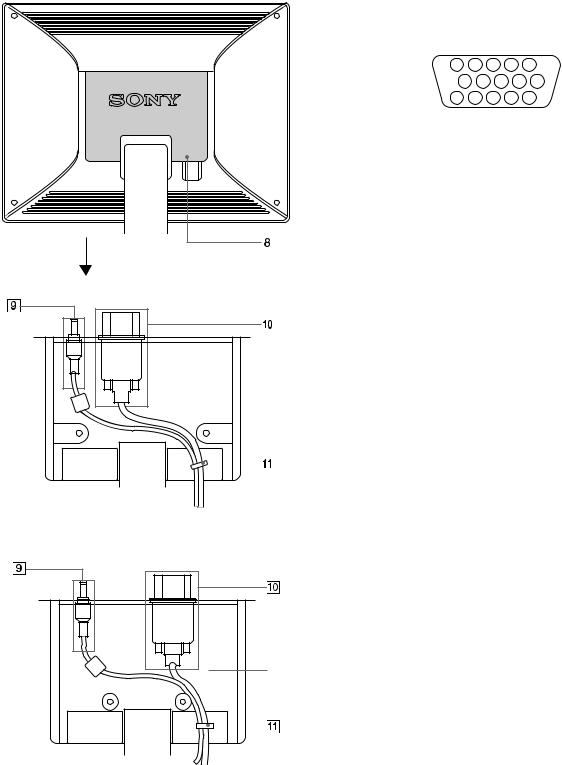
Rear of the LCD display
OPEN
Open the back cover.
SDM-S51
9DC IN connector (page 8)
This connector provides DC power to the display. Connect the AC adapter to this connector.
q; HD15 (RGB) input connector (page 7)
This connector inputs RGB video signals (0.7 Vp-p, positive) and SYNC signals.
|
|
|
|
|
5 |
|
4 |
3 |
2 |
1 |
|
|
|
|
|
10 |
9 |
8 |
7 |
6 |
|
|
|
|
|
|
15 |
14 |
13 12 |
11 |
||
|
|
|
|
|
|
|
|
|
|
|
|
|
|
|
Pin No. |
Signal |
|
|
|
|
|
|
|
|
|
|
|
|
|
|
||
|
1 |
Red |
|
|
|
|
|
|||
|
|
|
|
|
|
|
|
|
||
|
2 |
Green |
|
|
|
|
|
|||
|
|
|
|
|
(Sync on Green) |
|
|
|||
|
|
|
|
|
|
|
|
|
||
|
3 |
Blue |
|
|
|
|
|
|||
|
|
|
|
|
|
|
|
|||
|
|
4 |
ID (Ground) |
|
|
|
||||
|
|
|
|
|
||||||
|
|
|
|
|
|
|
|
|
||
|
5 |
DDC Ground* |
|
|
|
|||||
|
|
|
|
|
|
|
||||
|
6 |
Red Ground |
|
|
|
|||||
|
|
|
|
|
|
|
||||
|
7 |
Green Ground |
|
|
|
|||||
|
|
|
|
|
|
|
|
|
||
|
|
|
8 |
Blue Ground |
|
|
|
|||
|
|
|
|
|
|
|||||
|
|
|
|
|
|
|
|
|
|
|
|
|
|
|
|
|
|
|
|
|
|
|
9 |
DDC + 5V* |
|
|
|
|
||||
|
|
|
|
|
|
|
|
|
||
|
10 |
Ground |
|
|
|
|
|
|||
|
|
|
|
|
|
|
||||
|
11 |
ID (Ground) |
|
|
|
|||||
|
|
|
|
|||||||
|
12 |
Bi-Directional Data (SDA)* |
||||||||
|
|
|
|
|
|
|
|
|
||
|
13 |
H. Sync |
|
|
|
|
|
|||
|
|
|
|
|
|
|
|
|
||
|
14 |
V. Sync |
|
|
|
|
|
|||
|
|
|
|
|
|
|
||||
|
|
|
15 |
Data Clock (SCL)* |
|
|
||||
* DDC (Display Data Channel) is a standard of VESA.
qa Cable holder (page 8)
This part secures cables and cords to the monitor.
SDM-S71/S81
8Back cover (page 8)
Open this cover when you connect/disconnect cables or cords.
6

Setup
Before using your monitor, check that the following items are included in your carton:
•LCD display
•Power cord
•AC adapter
•HD15 (RGB) video signal cable
•Cord strap
•Windows Monitor Information/Windows Utility/Macintosh Utility Disk
•Warranty card
•This instruction manual
Step 1:Connect the display to your computer
Turn off the monitor and computer before connecting.
Notes
•Do not touch the pins of the video signal cable connector as this might bend the pins.
•Check the alignment of the HD15 connector to prevent bending the pins of the video signal cable connector.
xConnecting to an IBM PC/AT or compatible computer
to VIDEO output
IBM PC/AT or |
HD 15 (RGB) video |
compatible computer |
signal cable (supplied) |
x Connecting to a Macintosh or compatible computer
When connecting this monitor to a Macintosh computer, use the Macintosh adapter (not supplied) if necessary. Connect the Macintosh adapter to the computer before connecting the cable.
to video output |
HD15 (RGB) video |
|
signal cable (supplied) |
||
|
Macintosh or
compatible computer
GB
(continued)
7

Step 2:Connect the power cord
With the monitor and computer switched off, first connect the AC adapter and power cord to the monitor, then connect it to a power outlet.
to DC IN
OPEN
to a power outlet
power cord (supplied)
AC adapter (supplied)
This illustration of monitor rear is the SDM-S51.
The same applies for the SDM-S71/S81 model.
Step 3:Secure the cords and close the back cover
1 Remove the cable holder.
Cable holder
Illustrations of monitor rear are the SDM-S51.
The same applies for the SDM-S71/S81 model.
2Secure the cables and cords with the cable holder.
To close the back cover securely, bundle the cables and cords as illustrated.
Cable holder
3 Close the back cover.
Bandle the cables and cords
You can bandle the cables and cords by using the supplied cord strap.
Cord strap
8

Step 4:Turn on the monitor and computer
1Press the 1 (power) switch.
The indicator of the monitor lights up in green.
2 Turn on the computer.
The installation of your monitor is complete. If necessary, use the monitor’s controls to adjust the picture.
If no picture appears on your screen
•Check that the power cord and the video signal cable are properly connected.
•If NO INPUT SIGNAL appears on the screen, the computer is in the power saving mode. Try pressing any key on the keyboard or moving the mouse.
•If CABLE DISCONNECTED appears on the screen, check that the video input cable is properly connected.
•If OUT OF SCAN RANGE appears on the screen, reconnect the old monitor. Then adjust the computer’s graphic board so that the horizontal frequency is between 28 – 60 kHz (SDMS51), 28 – 92 kHz (SDM-S71/S81), and the vertical frequency is between 48 – 75 Hz (SDM-S51), 48 – 85 Hz (SDM-S71/ S81).
For more information about the on-screen messages, see “Trouble symptoms and remedies” on page 19.
GB
No need for specific drivers
The monitor complies with the “DDC” Plug & Play standard and automatically detects all the monitor’s information. No specific driver needs to be installed to the computer.
The first time you turn on your computer after connecting the monitor, the setup Wizard may appear on the screen. In this case, follow the on-screen instructions. The Plug & Play monitor is automatically selected so that you can use this monitor.
The vertical frequency turns to 60 Hz.
Since flickers are unobtrusive on the monitor, you can use it as it is. You do not need to set the vertical frequency to any particular high value.
If your computer or graphics board has difficulty communicating with this monitor, install the information file for this monitor using the Windows Monitor Information Disk. For details on installing, refer to the ReadMe file on the disk.
9
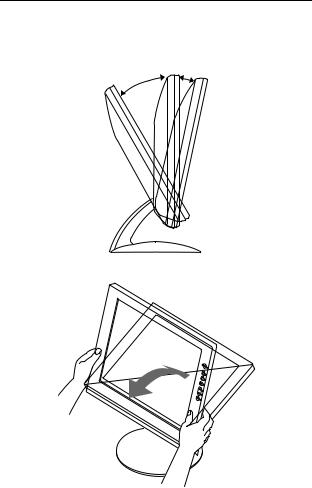
Adjusting the tilt
This display can be adjusted within the angles shown below.
5°
30°
Grasp the lower sides of the LCD panel, then adjust screen tilt.
To use the display comfortably
This display is designed so that you can set it up at a comfortable viewing angle. Adjust the viewing angle of your display according to the height of the desk and chair, and so that light is not reflected from the screen to your eyes.
10
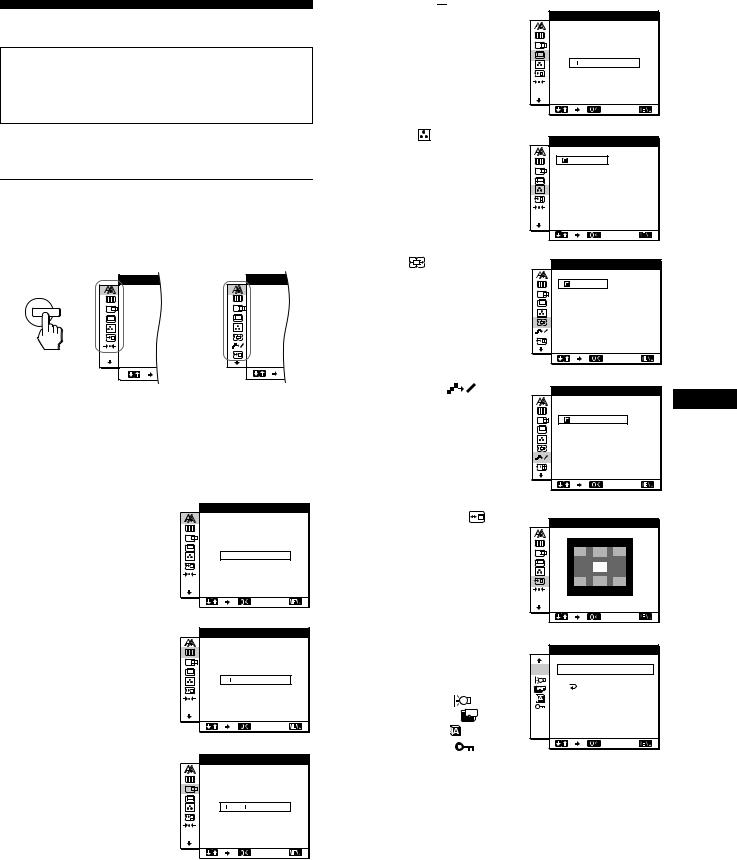
Customizing Your Monitor
Before making adjustments
Connect the monitor and the computer, and turn them on. Wait for at least 30 minutes before making adjustments for the best result.
You can make numerous adjustments to your monitor using the on-screen menu.
Navigating the menu
Press the MENU button to display the main menu on your screen. See page 12 for more information on using the MENU button.
|
PHA S E |
PHA SE |
MENU |
, |
|
|
|
EX I T |
SDM-S51 SDM-S71/S81
Use the M/m and OK buttons to select the icons in the above main menu illustration. The following 1~9menu appears. Keep pressing m to scroll down until the icons in menu 9appear. See page 12 for more information on using the M/m and OK buttons.
1PHASE  (page 13)
(page 13)
Select the PHASE menu to adjust the phase when the characters or pictures appear fuzzy throughout the entire screen. Adjust the phase after adjusting the pitch.
2PITCH  (page 13)
(page 13)
Select the PITCH menu to adjust the pitch when the characters or pictures are unclear in some areas of the screen.
3H CENTER 
 (page 13)
(page 13)
Select the H CENTER menu to adjust the picture’s horizontal centering.
PHA S E |
3 0 |
EX I T |
P I T C H |
1344 |
EX I T |
H CENT ER |
5 0 |
EX I T |
4V CENTER  (page 13)
(page 13)
Select the V CENTER menu to adjust the picture’s vertical centering.
V CENT ER |
5 0 |
EX I T |
5 COLOR |
(page 14) |
COLOR |
|
Select the COLOR menu to |
|
||
9 3 0 0 K |
|
||
adjust the color temperature |
|
||
6 5 0 0 K |
|
||
of the picture. This adjusts |
|
||
5 0 0 0 K |
|
||
the tone of the screen. |
USER |
|
|
L AD J U ST |
|
||
|
|
|
|
|
|
EX I T |
|
6 ZOOM |
(page 15) |
ZOOM |
|
(SDM-S71/S81 only) |
FUL L 2 |
|
|
Select the ZOOM menu to |
|
||
FUL L 1 |
|
||
adjust the picture’s size |
REA L |
|
|
|
|
||
according to the input |
|
|
|
signal’s aspect ratio or |
|
|
|
resolution. |
|
EX I T |
|
|
|
|
|
7 SMOOTHING |
SMOOTH I NG |
GB |
|
(page 15) (SDM-S71/S81 |
T EX T |
||
only) |
|
|
|
|
S T ANDARD |
|
|
Select the SMOOTHING |
GRAPH I CS |
|
|
|
|
||
menu to adjust the picture’s |
|
|
|
sharpness according to the |
|
|
|
type of an object displayed |
EX I T |
|
|
on the screen. |
|
||
|
|
||
8 MENU POSITION |
MENU POS I T I ON |
|
|
(page 15) |
|
|
|
|
|
|
|
Select the MENU |
|
|
|
POSITION to change the on- |
|
|
|
screen menu position. |
|
|
|
|
|
|
|
|
EX I T |
|
9 Other menus (page 16) |
|
RESE T |
|
|
||
Set the following menu |
|
|
|
|||
0 |
S CREEN |
RESE T |
||||
items. |
||||||
• |
RESET 0 |
|
A L L |
RESE T |
||
|
|
|
|
|||
• |
BACKLIGHT |
|
|
|
|
|
• |
POWER SAVE ZZ... |
|
|
|
|
|
• |
LANGUAGE |
|
|
|
|
|
• |
MENU LOCK |
|
|
|
EX I T |
|
(continued)
11
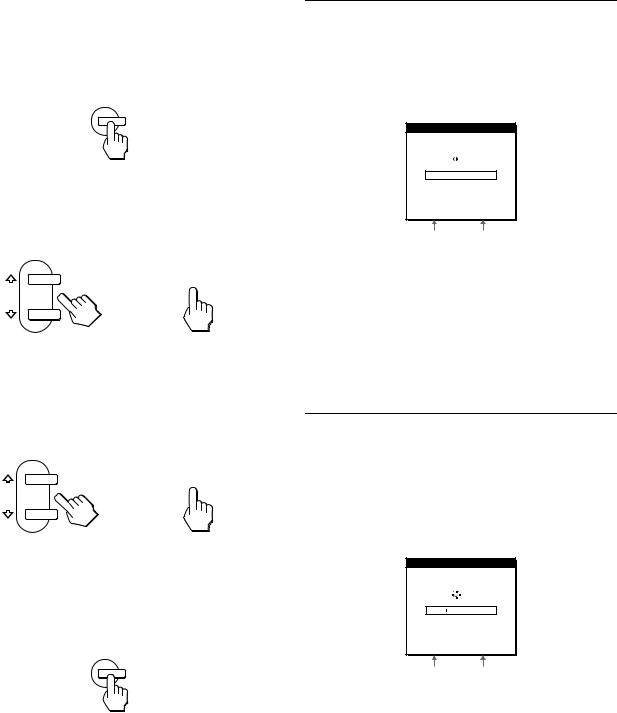
x Using the MENU, M/m, and OK buttons
1Display the main menu.
Press the MENU button to display the main menu on your screen.
MENU
2Select the menu you want to adjust.
Press the M/m buttons to display the desired menu. Press the OK button to select the menu item.
, OK 
3Adjust the menu.
Press the M/m buttons to make the adjustment, then press the OK button.
When you press the OK button, the setting are stored, then the display returns to the previous menu.
, OK 
4Close the menu.
Press the MENU button once to return to normal viewing. If no buttons are pressed, the menu closes automatically after about 30 seconds.
MENU
x Resetting the adjustments
You can reset the adjustments using the RESET menu. See page 16 for more information on resetting the adjustments.
Adjusting the contrast (CONTRAST)
Contrast adjustment is made using a separate CONTRAST menu from the main menu (page 11).
1Press the 6 (contrast) button.
The CONTRAST menu appears on the screen.
CONTRAS T
7 0
4 8 . 4 k H z / 6 0 H z
Horizontal frequency |
Vertical frequency of |
of the current input |
the current input |
signal |
signal |
Displaying the current input signal
The horizontal and vertical frequencies of the current input signal are displayed in the CONTRAST and BRIGHTNESS menu.
2 Press the M/m buttons to adjust the contrast.
The menu automatically disappears about 5 seconds after adjusting the contrast.
Adjusting the black level of an image (BRIGHTNESS)
Brightness adjustment is made using a separate BRIGHTNESS menu from the main menu (page 11).
1Press the 8 (brightness) button.
The BRIGHTNESS menu appears on the screen.
BR I GHT NESS
5 0
4 8 . 4 k H z / 6 0 H z
Horizontal frequency |
Vertical frequency of |
of the current input |
the current input |
signal |
signal |
2 Press the M/m buttons to adjust the brightness.
The menu automatically disappears about 5 seconds after adjusting brightness.
If the screen is too bright
Adjust the backlight. For more information about adjusting the backlight see “Adjusting the backlight” on page 16.
Note
You can adjust neither contrast nor brightness when displaying the main menu on the screen.
12
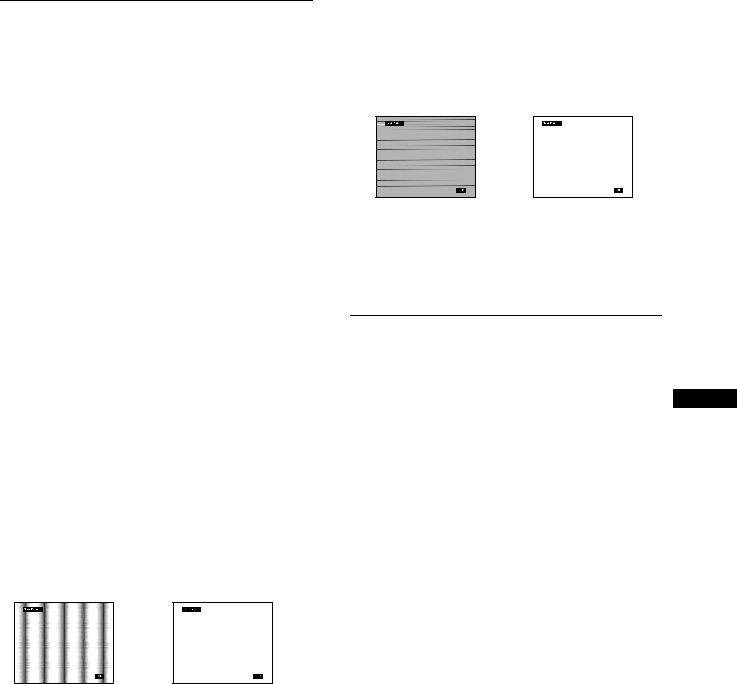
Eliminating flicker or blurring (PHASE/PITCH)
When the monitor receives an input signal, the automatic picture quality adjustment function of this monitor automatically adjusts the picture position, phase, and pitch, and ensures that a clear picture appears on the screen. For more information about this function, see “Automatic picture quality adjustment function” on page 17.
For some input signals, this function may not completely adjust the picture position, phase, and pitch. In this case, you can manually set these adjustments according the following instructions. If you manually set these adjustments, they are stored in memory and automatically recalled whenever the monitor receives the same input signals.
These settings may have to be repeated if you change the input signal after reconnecting your computer.
1Set the resolution to 1024 × 768 (SDM-S51), 1280 ×
1024 (SDM-S71/S81) on the computer.
2Load the Utility Disk.
3Start the Utility Disk and display the test pattern. For Windows
Click [Utility] t [Windows]/[Win Utility.exe].
For Macintosh
Click [Utility] t [Mac]/[Mac Utility].
4Press the MENU button.
The main menu appears on the screen.
5Press the M/m buttons to select  (PITCH) and press the OK button.
(PITCH) and press the OK button.
The PITCH menu appears on the screen.
6Press the M/m buttons until the vertical stripes disappear.
Adjust so that the vertical stripes disappear.
,
7Press the OK button.
The main menu appears on the screen.
If horizontal stripes are observed over the entire screen, adjust the phase as the next step.
8Press the M/m buttons to select  (PHASE) and press the OK button.
(PHASE) and press the OK button.
The PHASE menu appears on the screen.
9Press the M/m buttons until the horizontal stripes are at a minimum.
Adjust so that the horizontal stripes are at a minimum.
,
10 Click [END] on the screen to turn off the test pattern.
To reset the automatic picture quality adjustment
Select SCREEN RESET and activate it using the RESET menu. See page 16 for more information on using the RESET menu.
Adjusting the picture position (H CENTER/V CENTER)
If the picture is not in the center of the screen, adjust the picture’s centering as follows. GB These settings may have to be repeated if you change the input
signal after reconnecting your computer.
1Start the Utility Disk and display the test pattern.
Repeat steps 2 and 3 of “Eliminating flicker or blurring (PHASE/PITCH).”
2Press the MENU button.
The main menu appears on the screen.
3Press the M/m buttons to select 
 (H CENTER) or
(H CENTER) or
 (V CENTER) and press the OK button.
(V CENTER) and press the OK button.
The H CENTER or V CENTER menu appears on the screen.
4Move the picture up, down, left, or right until the frame at the perimeter of the test pattern disappears.
Press the M/m buttons to adjust the picture’s centering using the H CENTER menu for horizontal adjustment, or the V CENTER menu for vertical adjustment.
5Click [END] on the screen to turn off the test pattern.
13

Adjusting the color temperature (COLOR)
The COLOR settings allow you to adjust the picture’s color temperature by changing the color level of the white color field. Colors appear reddish if the temperature is low, and bluish if the temperature is high.
You can set the color temperature to 9300K, 6500K, 5000K or user adjustment.
1Press the MENU button.
The main menu appears on the screen.
2Press the M/m buttons to select 

 (COLOR) and press the OK button.
(COLOR) and press the OK button.
The COLOR menu appears on the screen.
3Press the M/m buttons to select the desired color temperature and press the OK button.
The preset color temperatures are 9300K, 6500K, and 5000K. Since the default setting is 9300K, the whites will change from a bluish hue to a reddish hue as the temperature is lowered to 6500K and 5000K.
4If necessary, fine tune the color temperature.
First press the M/m buttons to select ADJUST and press the OK button. Then press the M/m buttons to select R (Red) or B (Blue) and press the OK button, and then press the M/m buttons to adjust the color temperature and press the OK button. Since this adjustment changes the color temperature by increasing or decreasing the R and B components with respect to G (green), the G component is fixed.
USE R AD J USTMENT |
|
R |
5 0 |
G |
5 0 |
B |
5 0 |
GAMMA 1 |
|
GAMMA 2 |
|
GAMMA 3 |
|
|
EX I T |
If you fine tune the color temperature, the new color setting is stored in memory for USER ADJUSTMENT and automatically recalled whenever USER is selected.
To change the GAMMA setting
You can select the GAMMA setting from “GAMMA 1” – “GAMMA 3.” The highest setting is “GAMMA 3.”
1Press the MENU button.
The main menu appears on the screen.
2Press the M/m buttons to select 

 (COLOR) and press the OK button.
(COLOR) and press the OK button.
The COLOR menu appears on the screen.
3Change the GAMMA setting.
First press the M/m buttons to select ADJUST and press the OK button. Then press the M/m buttons to select GAMMA 1 to GAMMA 3 and press the OK button.
USE R AD J USTMENT |
|
R |
5 0 |
G |
5 0 |
B |
5 0 |
GAMMA 1 |
|
GAMMA 2 |
|
GAMMA 3 |
|
|
EX I T |
If you change the GAMMA setting, the new setting is automatically recalled whenever USER is selected.
To return to the main menu
Press the M/m buttons to select  , then press the OK button.
, then press the OK button.
14

Changing the picture size according to the signal (ZOOM) (SDM-S71/S81 only)
The monitor is set to display the picture on the screen in full, irrespective of the picture’s mode or resolution in the default setting. You can also view the picture at its actual aspect ratio or resolution.
1Press the MENU button.
The main menu appears on the screen.
2Press the M/m buttons to select 
 (ZOOM) and press the OK button.
(ZOOM) and press the OK button.
The ZOOM menu appears on the screen.
3Press the M/m buttons to select the desired mode.
1280 × 1024 resolution signals fill the entire screen and ZOOM is not possible regardless of these settings.
•FULL2: The input signal is displayed on the screen in full, irrespective of the picture’s mode or resolution.
•FULL1: The input signal is displayed on the screen at its actual aspect ratio. Therefore, black bands may appear at the top and bottom of the picture depending on the signal.
•REAL: The input signal is displayed on the screen at its actual resolution. Sub-SXGA signals are displayed at the center of the screen surrounded by a black frame.
To restore the default setting (displayed on the screen in full)
Select “FULL2” in step 3.
Smoothing the picture (SMOOTHING) (SDM-S71/S81 only)
If the picture displayed at the FULL2 or FULL1 mode of ZOOM is not smooth, use the picture smoothing function. Note that 1280 × 1024 resolution signals are shown only in REAL mode and SMOOTHING is not possible.
1Press the MENU button.
The main menu appears on the screen.
2Press the M/mbuttons to select 

 (SMOOTHING), and press the OK button.
(SMOOTHING), and press the OK button.
The SMOOTHING menu appears on the screen.
3Press the M/m buttons to select the desired mode.
The smoothing effect becomes stronger in the order of TEXTtSTANDARDtGRAPHICS.
•TEXT: To make the characters appear clear. (This mode is suited for text-based applications.)
•STANDARD: Standard smoothing effect (factory preset smoothing effect)
•GRAPHICS: To make the pictures appear clean. (This mode is suited for CD-ROM software such as photo images or illustrations.)
Note
When you set the ZOOM menu to REAL, the SMOOTHING menu is not available.
Changing the menu’s position (MENU POSITION)
You can change the menu position if it is blocking an image on the screen.
1Press the MENU button.
The main menu appears on the screen.
2Press the M/m buttons to select  (MENU
(MENU
POSITION) and press the OK button.
3Press the M/m buttons to select the desired position and press the OK button.
There are three positions each for the top of the screen and the bottom of the screen, and one for the screen center.
GB
15

Additional settings
You can adjust the following options:
•RESET 0
•BACKLIGHT 


•POWER SAVE  ZZ...
ZZ...
•LANGUAGE 

•MENU LOCK 
1Press the MENU button.
The main menu appears on the screen.
2Keep pressing the m button until the icon of the desired option item appears.
3Press the M/m buttons to select the desired option item and press the OK button.
Adjust the selected option item according to the following instructions.
xAdjusting the picture quality automatically (SCREEN RESET)/
Resetting the adjustment data to the defualt
(ALL RESET)
First press the M/m buttons to select 0 (RESET) and press the OK button. Then press the M/m buttons to select the desired mode.
•SCREEN RESET (Automatic picture quality adjustment function): Adjusts the pictur’s appropriate phase, pitch, and holizontal/vertical position automatically for the current input signal and memorizes the adjustment data.
•ALL RESET: Resets all settings and adjustment data, except the LANGUAGE menu setting, to the default setting. This function resets the automatic adjustment data memorized by SCREEN RESET to the default setting.
• : To cancel resetting and return to the menu screen.
: To cancel resetting and return to the menu screen.
x Adjusting the backlight
If the screen is too bright, adjust the backlight.
First press the M/m buttons to select 

 (BACKLIGHT) and press the OK button. Then press the M/m buttons to adjust the desired light level.
(BACKLIGHT) and press the OK button. Then press the M/m buttons to adjust the desired light level.
x Setting up the power saving mode
This monitor has a function which enables it to enter the power save mode automatically according to the power saving settings of the computer. You can prevent the monitor from entering the power saving mode by setting the following option to OFF.
For more information of the power saving mode, see page 17.
First press the M/m buttons to select  ZZ... (POWER
ZZ... (POWER
SAVE) and press the OK button. Then press the M/m buttons to select either ON or OFF.
x Selecting the on-screen menu language
English, German, French, Spanish, Italian and Japanese versions of the on-screen menus are available. The default setting is English.
First press the M/m buttons to select 
 (LANGUAGE) and press the OK button. Then press the M/m button to select a language and press the OK button.
(LANGUAGE) and press the OK button. Then press the M/m button to select a language and press the OK button.
•ENGLISH
•DEUTSCH: German
•FRANÇAIS: French
•ESPAÑOL: Spanish
•ITALIANO: Italian
•
 : Japanese
: Japanese
x Locking the menus and controls
First press the M/m buttons to select  (MENU LOCK) and press the OK button. Then press the M/m buttons and select ON.
(MENU LOCK) and press the OK button. Then press the M/m buttons and select ON.
Only the 1 (power) switch, and  (MENU LOCK) of the option menu will operate. If any other items are selected, the
(MENU LOCK) of the option menu will operate. If any other items are selected, the  mark appears on the screen.
mark appears on the screen.
To cancel the menu lock
Repeat the procedure above and set and  (MENU LOCK) to OFF.
(MENU LOCK) to OFF.
16

Technical Features
Power saving function
This monitor meets the power-saving guidelines set by VESA, ENERGY STAR, and NUTEK. If the monitor is connected to a computer or video graphics board that is DPMS (Display Power Management Signaling) compliant, the monitor will automatically reduce power consumption as shown below.
SDM-S51
Power mode |
Power consumption |
1 (power) |
|
|
indicator |
|
|
|
normal |
25 W (max.) |
green |
operation |
|
|
|
|
|
active off* |
3 W (max.) |
orange*** |
(deep sleep)** |
|
|
|
|
|
power off |
3 W (max.) |
off |
|
|
|
SDM-S71
Power mode |
Power consumption |
1 (power) |
|
|
indicator |
|
|
|
normal |
45 W (max.) |
green |
operation |
|
|
|
|
|
active off* |
3 W (max.) |
orange*** |
(deep sleep)** |
|
|
|
|
|
power off |
3 W (max.) |
off |
|
|
|
SDM-S81
Power mode |
Power consumption |
1 (power) |
|
|
indicator |
|
|
|
normal |
50 W (max.) |
green |
operation |
|
|
|
|
|
active off* |
3 W (max.) |
orange*** |
(deep sleep)** |
|
|
|
|
|
power off |
3 W (max.) |
off |
|
|
|
*When your computer enters the “active off” mode, the input signal is cut and NO INPUT SIGNAL appears on the screen. After 20 seconds, the monitor enters the power saving mode.
**“deep sleep” is the power saving mode defined by the Environmental Protection Agency.
***If only the horizontal or vertical sync signal is input to the monitor, the power indicator may alternately flash green and orange.
Automatic picture quality adjustment function
When the monitor receives an input signal, it automatically matches the signal to one of the factory preset modes stored in the monitor’s memory to provide a high quality picture at the center of the screen. (See Appendix for a list of the factory preset modes.)
For input signals that do not match one of the factory preset modes, the automatic picture quality adjustment function of this monitor automatically adjusts the picture position, phase, and pitch, and ensures that a clear picture appears on the screen for any timing within the monitor’s frequency range (horizontal: 28 – 60 kHz (SDM-S51), 28 – 92 kHz (SDM-S71/S81), vertical: 48 – 75 Hz (SDM-S51), 48 – 85 Hz (SDM-S71/S81)). Consequently, the first time the monitor receives input signals that do not match one of the factory preset modes, the monitor may take a longer time than normal for displaying the picture on the screen. This adjustment data is automatically stored in memory so that next time, the monitor will function in the same way as when the monitor receives the signals that match one of the factory preset modes.
In all modes as above, if the picture is adjusted, the adjustment data is stored as a user mode and automatically recalled whenever the same input signal is received.
Note |
GB |
While the automatic picture quality adjustment function is activated, only the 1 (power) switch will operate.
17
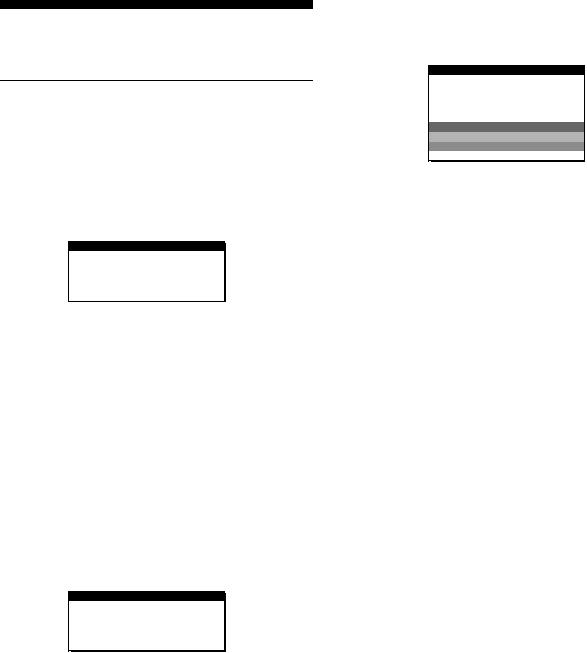
Troubleshooting
Before contacting technical support, refer to this section.
On-screen messages
If there is something wrong with the input signal, one of the following messages appears on the screen. To solve the problem, see “Trouble symptoms and remedies” on page 19.
If OUT OF SCAN RANGE appears on the screen
This indicates that the input signal is not supported by the monitor’s specifications. Check the following items.
 I NFORMA T I ON
I NFORMA T I ON
OUT OF SCAN RANGE
x x . x k H z / x x H z
If “xx.x kHz/xx Hz” is displayed
This indicates that either the horizontal or vertical frequency is not supported by the monitor’s specifications.
The figures indicate the horizontal and vertical frequencies of the current input signal.
If “RESOLUTION > XGA” is displayed (SDM-S51)
This indicates that the resolution is not supported by the monitor’s specifications.
If “RESOLUTION > SXGA” is displayed (SDM-S71/ S81)
This indicates that the resolution is not supported by the monitor’s specifications.
If NO INPUT SIGNAL appears on the screen
This indicates that no signal is input.
 I NFORMA T I ON
I NFORMA T I ON
NO I NPUT S I GNA L
GO TO POWER SAVE
GO TO POWER SAVE
The monitor will enter the power saving mode after about 5 seconds from the message is displayed.
If CABLE DISCONNECTED appears on the screen
This indicates that the video signal cable has been disconnected from the currently selected connector.
 I NFORMA T I ON
I NFORMA T I ON
CAB L E D I SCONNECT ED
GO TO POWER SAVE
GO TO POWER SAVE
The monitor will enter the power saving mode after about 5 seconds from the message is displayed.
18

Trouble symptoms and remedies
If a problem is caused by the connected computer or other equipment, please refer to the connected equipment’s instruction manual. Use the self-diagnosis function (page 21) if the following recommendations do not resolve the problem.
Symptom |
Check these items |
No picture
If the 1 (power) indicator is not lit, or if the 1 (power) indicator will not light up when the 1 (power) switch is pressed
•Check that the power cord is properly connected.
•Check that the 1 (power) switch is in the “on” position.
If the 1 (power) indicator is green |
• Use the self-diagnostics function (page 21). |
or flashing orange |
|
|
|
If CABLE DISCONNECTED |
• Check that the video signal cable is properly connected and all plugs are firmly seated in |
appears on the screen |
their sockets (page 7). |
|
• Check that the video input connector’s pins are not bent or pushed in. |
|
• A non-supplied video signal cable is connected. If you connect a non-supplied video |
|
signal cable, CABLE DISCONNECTED may appear on the screen before entering the |
|
power saving mode. This is not a malfunction. |
If NO INPUT SIGNAL appears on the screen, or the 1 (power) indicator is either orange or alternating between green and orange
•Check that the video signal cable is properly connected and all plugs are firmly seated in their sockets (page 7).
•Check that the video input connector’s pins are not bent or pushed in.
xProblems caused by the connected computer or other equipment
•The computer is in the power saving mode. Try pressing any key on the keyboard or moving the mouse.
•Check that your graphic board is attached to the computer properly.
•Check that the computer’s power is “on.”
If OUT OF SCAN RANGE appears xProblems caused by the connected computer or other equipment
on the screen • Check that the video frequency range is within that specified for the monitor. If you replaced an old monitor with this monitor, reconnect the old monitor and adjust the
frequency range to the following:
Horizontal: 28 – 60 kHz (SDM-S51), 28 – 92 kHz (SDM-S71/S81) Vertical frequency: 48 – 75 Hz (SDM-S51), 48 – 85 Hz (SDM-S71/S81)
GB
If using Windows |
• If you replaced an old monitor with this monitor, reconnect the old monitor and do the |
|
following. Select “SONY” from the “Manufactures” list and select “SDM-S51” or “SDM- |
|
S71”or “SDM-S81” from the “Models” list in the Windows device selection screen. If |
|
“SDM-S51” or “SDM-S71”or “SDM-S81” does not appear in the “Models” list, try “Plug |
|
& Play” or install the information file for this monitor using the Windows Monitor |
|
Information Disk (page 9). |
|
|
If using a Macintosh system |
• If you use the Macintosh adapter (not supplied), check that the Macintosh adapter and the |
|
video signal cable are properly connected (page 7). |
Picture flickers, bounces, oscillates, or is scrambled
•Adjust the pitch and phase (page 13).
•Try plugging the monitor into a different AC outlet, preferably on a different circuit.
•Change the orientation of the display.
xProblems caused by the connected computer or other equipment
•Check your graphics board manual for the proper monitor setting.
•Confirm that the graphics mode (VESA, Macintosh 19" Color, etc.) and the frequency of the input signal are supported by this monitor (Appendix). Even if the frequency is within the proper range, some graphic boards may have a sync pulse that is too narrow for the monitor to sync correctly.
•Adjust the computer’s refresh rate (vertical frequency) to obtain the best possible picture.
(continued)
19

Symptom |
Check these items |
|
Picture is fuzzy |
• |
Adjust the brightness and contrast (page 12). |
|
• |
Adjust the pitch and phase (page 13). |
xProblems caused by the connected computer or other equipment
•Set the resolution to XGA (1024 × 768) on your computer (SDM-S51).
•Set the resolution to SXGA (1280 × 1024) on your computer (SDM-S71/S81).
Picture is ghosting |
• |
Eliminate the use of video cable extensions and/or video switch boxes. |
|
• |
Check that all plugs are firmly seated in their sockets. |
Picture is not centered or sized properly
•Adjust the pitch and phase (page 13).
•Adjust the picture position (page 13). Note that some video modes do not fill the screen to the edges.
Picture is too small |
• Set the zoom setting to FULL2 (page 15) (SDM-S71/S81 only). |
|
|
|
xProblems caused by the connected computer or other equipment |
|
|
• Set the computer’s resolution to the screen’s resolution. |
|
|
|
The picture is dark |
• Adjust the brightness (page 12). |
|
|
|
• Adjust the backlight (page 16). |
|
|
• It takes a few minutes for the display to become bright after turning on the monitor. |
|
|
|
Wavy or elliptical pattern (moire) |
• Adjust the pitch and phase (page 13). |
|
is visible |
|
|
|
|
|
Color is not uniform |
• Adjust the pitch and phase (page 13). |
|
|
|
|
White does not look white |
• Adjust the color temperature (page 14). |
|
|
|
|
Monitor buttons do not operate |
• If the menu lock is set to ON, set it to OFF (page 16). |
|
( |
appears on the screen) |
|
|
|
|
The monitor turns off after a while |
• Set the power saving function to OFF (page 16). |
|
|
|
xProblems caused by the connected computer or other equipment |
|
|
• Set the computer’s power saving setting to off. |
|
|
|
Displaying this monitor’s name, serial number, and date of manufacture.
While the monitor is receiving a video signal, press and hold the MENU button for more than 5 seconds.
The monitor’s information box appears. Press the MENU button again to make the box disappear.
MENU
Example
INFORMATION
 Model name
Model name
MODEL : SDM-S51
SER NO : 1234567  Serial number MANUFACTURED : 2001-52
Serial number MANUFACTURED : 2001-52
 Week and year of manufacture
Week and year of manufacture
If any problem persists, call your authorized Sony dealer and give the following information:
•Model name: SDM-S51 or SDM-S71 or SDM-S81
•Serial number
•Name and specifications of your computer and graphics board.
20

Self-diagnosis function
This monitor is equipped with a self-diagnosis function. If there is a problem with your monitor or computer(s), the screen will go blank and the 1 (power) indicator will either light up green or flash orange. If the 1 (power) indicator is lit in orange, the computer is in power saving mode. Try pressing any key on the keyboard or moving the mouse.
1 (power) indicator
If the 1 (power) indicator is green
1 |
Turn off the 1 (POWER) switch and disconnect the |
|
|
video signal cables from the monitor. |
GB |
2 |
Turn the monitor on by pressing the 1 (POWER) |
|
|
switch. |
|
If all four color bars appear (white, red, green, blue), the monitor is working properly. Reconnect the video input cables and check the condition of your computer(s).
If the color bars do not appear, there is a potential monitor failure.
Inform your authorized Sony dealer of the monitor’s condition.
If the 1 (power) indicator is flashing orange
Press the 1 (power) switch twice to turn the monitor off and then on.
If the 1 (power) indicator lights up green, the monitor is working properly.
If the 1 (power) indicator is still flashing, there is a potential monitor failure. Count the number of seconds between orange flashes of the 1 (power) indicator and inform your authorized Sony dealer of the monitor’s condition. Be sure to note the model name and serial number of your monitor. Also note the make and model of your computer and graphic board.
21

Specifications
SDM-S51
LCD panel |
Panel type: a-Si TFT Active Matrix |
|
Picture size: 15.0 inch |
Input signal format |
RGB operating frequency* |
|
Horizontal: 28 – 60 kHz |
|
Vertical: 48 – 75 Hz |
Resolution |
Horizontal: Max.1024 dots |
|
Vertical: Max.768 lines |
Input signal levels |
RGB video signal |
|
0.7 Vp-p, 75 Ω, positive |
|
SYNC signal |
|
TTL level, 2.2 kΩ, |
|
positive or negative |
|
(Separate horizontal and vertical, |
|
or composite sync) |
|
0.3 Vp-p, 75Ω, negative |
|
(Sync on green) |
Power requirements |
100 – 240 V, 50 – 60 Hz, |
|
Max. 0.8 A |
DC input |
DC 12 V (supplied AC adapter) |
Power consumption |
Max. 25 W |
Operating temperature |
5 – 35 °C |
Dimensions (width/height/depth) |
|
|
Display (upright): |
|
Approx. 387 × 330 × 175 mm |
|
(15 1/4 × 13 × 7 inches) |
|
(with stand) |
|
Approx. 387 × 281 × 48 mm |
|
(15 1/4 × 11 1/8 × 1 15/16 inches) |
|
(without stand) |
Mass |
Approx. 3.7 kg (8 lb 3 oz) (with |
|
stand) |
|
Approx. 2.9 kg (6 lb 5 oz) |
|
(without stand) |
Plug & Play |
DDC2B |
Accessories |
See page 7. |
SDM-S71/S81
LCD panel |
Panel type: a-Si TFT Active Matrix |
|
Picture size: 17.0 inch (SDM-S71) |
|
Picture size: 18.0 inch (SDM-S81) |
Input signal format |
RGB operating frequency* |
|
Horizontal: 28 – 92 kHz |
|
Vertical: 48 – 85 Hz |
Resolution |
Horizontal: Max.1280 dots |
|
Vertical: Max.1024 lines |
Input signal levels |
RGB video signal |
|
0.7 Vp-p, 75 Ω, positive |
|
SYNC signal |
|
TTL level, 2.2 kΩ, |
|
positive or negative |
|
(Separate horizontal and vertical, |
|
or composite sync) |
|
0.3 Vp-p, 75Ω, negative |
|
(Sync on green) |
Power requirements |
100 – 240 V, 50 – 60 Hz, |
|
Max. 1.5 A |
DC input |
DC 12 V (supplied AC adapter) |
Power consumption |
Max. 45 W (SDM-S71) |
|
Max. 50 W (SDM-S81) |
Operating temperature |
5 – 35 °C |
Dimensions (width/height/depth) |
|
|
Display (upright): |
|
Approx. 423 × 399 × 233 mm |
|
(16 3/4 × 15 3/4 × 9 1/4 inches) |
|
(with stand) (SDM-S71) |
|
Approx. 439 × 416 × 233 mm |
|
(17 3/8 × 16 1/2 × 9 1/4 inches) |
|
(with stand) (SDM-S81) |
|
Approx. 423 × 340 × 62 mm |
|
(16 3/4 × 13 1/2 × 2 1/2 inches) |
|
(without stand) (SDM-S71) |
|
Approx. 439 × 357 × 60 mm |
|
(17 3/8 × 14 1/8 × 2 3/8 inches) |
|
(without stand) (SDM-S81) |
Mass |
Approx. 6.5 kg (14 lb 5 oz) (with |
|
stand) (SDM-S71) |
|
Approx. 6.8 kg (14 lb 16 oz) (with |
|
stand) (SDM-S81) |
|
Approx. 4.8 kg (10 lb 9 oz) |
|
(without stand) (SDM-S71) |
|
Approx. 5.1 kg (11 lb 4 oz) |
|
(without stand) (SDM-S81) |
Plug & Play |
DDC2B |
Accessories |
See page 7. |
*Recommended horizontal and vertical timing condition
•Horizontal sync width duty should be more than 4.8% of total horizontal time or 0.8 µs, whichever is larger.
•Horizontal blanking width should be more than 2.5 µsec.
•Vertical blanking width should be more than 450 µsec.
Design and specifications are subject to change without notice.
22

Table des matières
Précautions. . . . . . . . . . . . . . . . . . . . . . . . . . . . . . . . . . . . . . . . . . . . 4
Identification des composants et des commandes . . . . . . . . . . . . . . 5
Installation . . . . . . . . . . . . . . . . . . . . . . . . . . . . . . . . . . . . .7
Etape 1 : Raccordez l’écran à votre ordinateur . . . . . . . . . . . . . . . . 7 Etape 2 : Branchez le câble d’alimentation . . . . . . . . . . . . . . . . . . . 8 Etape 3 : Vérifiez que tous les câbles et cordons sont bien raccordés et refermez le capot arrière. . . . . . . . . . . . . . . . . . . . . . . . . . . . . . . . 8 Etape 4 : Mettez le moniteur et l’ordinateur sous tension . . . . . . . . 9 Réglage de l’inclinaison . . . . . . . . . . . . . . . . . . . . . . . . . . . . . . . . . 10
•Macintosh est une marque commerciale sous licence d’Apple Computer, Inc., déposée aux Etats-Unis et dans d’autres pays.
•Windowsâ et MS-DOS sont des marques commerciales déposées de Microsoft Corporation aux Etats-Unis et dans d’autres pays.
•IBM PC/AT et VGA sont des marques commerciales déposées d’IBM Corporation of the U.S.A.
•VESA et DDCä sont des marques commerciales de Video Electronics Standard Association.
•ENERGY STAR est une marque déposée aux Etats-Unis.
•Tous les autres noms de produit mentionnés dans le présent mode d'emploi peuvent être des marques commerciales ou des marques commerciales déposées de leurs entreprises respectives.
•De plus, les symboles “ä” et “â” ne sont pas systématiquement mentionnés dans ce mode d’emploi.
Personnalisation de votre moniteur. . . . . . . . . . . . . . . .11
Pilotage par menu. . . . . . . . . . . . . . . . . . . . . . . . . . . . . . . . . . . . . . |
11 |
|
Réglage du contraste (CONTRASTE) . . . . . . . . . . . . . . . . . . . . . . |
12 |
|
Réglage du niveau de noir de l’image (LUMINOSITE) . . . . . . . . . . |
12 |
|
Suppression du scintillement ou du flou |
|
|
(PHASE/HORLOGE) . . . . . . . . . . . . . . . . . . . . . . . . . . . . . . . . . . . |
13 |
|
Réglage de la position de l’image |
|
|
(CENTRAGE H/CENTRAGE V) |
13 |
|
FR |
||
. . . . . . . . . .Réglage de la température des couleurs (COULEUR) |
14 |
|
Modification de la taille de l’image selon le signal |
|
|
(ZOOM) (SDM-S71/S81 uniquement) . . . . . . . . . . . . . . . . . . . . . . |
15 |
|
Lissage de l’image (SMOOTHING) (SDM-S71/S81 uniquement) . 15 |
|
|
Changement de la position du menu (POSITION MENU) . . . . . . . |
15 |
|
Réglages additionnels . . . . . . . . . . . . . . . . . . . . . . . . . . . . . . . . . . |
16 |
|
Spécifications techniques. . . . . . . . . . . . . . . . . . . . . . . .17
Fonction d’économie d’énergie. . . . . . . . . . . . . . . . . . . . . . . . . . . . 17 Fonction de réglage automatique de la qualité de l’image . . . . . . . 17
Dépannage . . . . . . . . . . . . . . . . . . . . . . . . . . . . . . . . . . . .18
Messages affichés . . . . . . . . . . . . . . . . . . . . . . . . . . . . . . . . . . . . . 18 Symptômes de défaillances et remèdes. . . . . . . . . . . . . . . . . . . . . 19 Fonction d’autodiagnostic . . . . . . . . . . . . . . . . . . . . . . . . . . . . . . . . 21
Spécifications. . . . . . . . . . . . . . . . . . . . . . . . . . . . . . . . . .22
Appendix. . . . . . . . . . . . . . . . . . . . . . . . . . . . . . . . . . . . . . . i
Preset mode timing table . . . . . . . . . . . . . . . . . . . . . . . . . . . . . . . . . .i
3
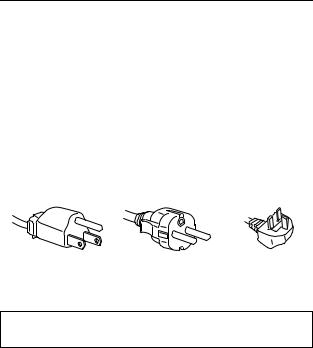
Précautions
Avertissement sur les connexions d’alimentation
•Utilisez le câble d’alimentation fourni. Si vous utilisez un câble d’alimentation différent, assurez-vous qu’il est compatible avec la tension secteur locale.
Pour les clients aux Etats-Unis
Si vous n’employez pas le câble approprié, ce moniteur ne sera pas conforme aux normes FCC obligatoires.
Pour les clients au Royaume-Uni
Si vous utilisez le moniteur au Royaume-Uni, veuillez utiliser le câble d’alimentation adapté au Royaume-Uni.
Exemples de types de fiches
pour 100 à 120 V CA pour 200 à 240 V CA pour 240 V CA uniquement
A n’utiliser qu’avec l’adaptateur secteur AC-V012C pour SDM-S51, AC-V012E pour SDM-S71/S81.
L’appareil doit être installé à proximité d’une prise de courant aisément accessible.
Installation
N’installez pas et ne laissez pas le moniteur :
•A des endroits exposés à des températures extrêmes, par exemple à proximité d’un radiateur, d’un conduit de chauffage ou le rayonnement direct du soleil. L’exposition du moniteur à des températures extrêmes, comme dans l’habitacle d’une voiture parquée en plein soleil ou à proximité d’un conduit de chauffage, risque d’entraîner des déformations du châssis ou des dysfonctionnements.
•A des endroits soumis à des vibrations mécaniques ou à des chocs.
•A proximité d’appareils générant de puissants champs magnétiques, comme un téléviseur ou d’autres appareils électroménagers.
•A des endroit soumis à des quantités inhabituelles de poussière, de saletés ou de sable, par exemple à côté d’une fenêtre ouverte ou d’une porte donnant sur l’extérieur. En cas d’installation temporaire à l’extérieur, veillez à prendre les précautions requises contre la poussière et les saletés en suspension dans l’air. Faute de quoi des dommages irréparables risquent de se produire.
Manipulation de l’écran LCD
•Ne laissez pas l’écran LCD face au soleil, car vous risquez sinon de l’endommager. Faites donc attention si vous installez le moniteur à côté d’une fenêtre.
•N’appuyez pas sur et veillez à ne pas érafler la surface de l’écran LCD. Ne posez pas d’objets lourds sur l’écran LCD. Vous risquez sinon d’altérer l’uniformité de l’écran ou de provoquer un dysfonctionnement de l’écran LCD.
•Lorsque le moniteur est employé dans un environnement froid, il est possible qu’une image rémanente apparaisse sur l’écran. Il ne s’agit pas d’un dysfonctionnement. L’écran recouvre sa condition normale dès que la température est revenue à un niveau normal.
•Si une image fixe reste affichée pendant une longue durée, il se peut qu’une image rémanente apparaisse pendant un certain temps. Cette image rémanente finira par disparaître.
•Le panneau LCD s’échauffe en cours d’utilisation. Il ne s’agit pas d’un dysfonctionnement.
Remarque sur l’affichage à cristaux liquides (LCD - Liquid Crystal Display)
Veuillez noter que l’écran LCD est issu d’une technologie de haute précision. Toutefois, il est possible que des points noirs ou des points brillants de lumière (rouge, bleu ou vert) apparaissent constamment sur l’écran LCD, ainsi que des bandes de couleurs irrégulières ou une certaine luminosité. Il ne s’agit pas d’un dysfonctionnement.
(Points effectifs : supérieurs à 99,99%)
Remplacement du tube fluorescent
Un tube fluorescent de conception spéciale est installé dans ce moniteur comme source lumineuse. Si l’écran s’assombrit, est instable ou ne s’allume pas, remplacez le tube fluorescent. Pour le remplacement du tube fluorescent, consultez votre revendeur Sony.
Entretien
•Débranchez le câble d’alimentation de la prise secteur avant de procéder au nettoyage de votre moniteur.
•Nettoyez l’écran LCD avec un chiffon doux. Si vous utilisez un liquide de nettoyage pour le verre, n’utilisez pas de nettoyant contenant une solution antistatique ou tout autre additif similaire, car vous risquez sinon de griffer le revêtement de l’écran LCD.
•Nettoyez le châssis, le panneau et les commandes à l’aide d’un chiffon doux légèrement imprégné d’une solution détergente neutre. N’utilisez aucun type de tampon abrasif, de poudre à récurer ou de solvant tel que de l’alcool ou de la benzine.
•Ne frottez pas, ne touchez pas et ne tapotez pas la surface de l’écran avec des objets pointus ou abrasifs comme un stylo à bille ou un tournevis. Ce type de contact risque de rayer le tube image.
•Sachez qu’une détérioration des matériaux ou du revêtement de l’écran LCD risque de se produire si le moniteur est exposé à des solvants volatiles comme des insecticides ou en cas de contact prolongé avec des objets en caoutchouc ou en vinyle.
Transport
•Débranchez tous les câbles du moniteur et saisissez le moniteur fermement des deux mains par son support et sa base. Si vous laissez tomber le moniteur, vous risquez de vous blesser ou d’endommager le moniteur.
•Pour transporter ce moniteur en vue de réparations ou de son expédition, utilisez le carton et les matériaux de conditionnement originaux.
Elimination du moniteur
•N’éliminez pas ce moniteur avec les ordures ménagères.
•Le tube fluorescent utilisé dans ce moniteur contient du mercure. L’élimination de ce moniteur doit être effectuée conformément aux réglementations des autorités locales compétentes en matière de propreté publique.
4
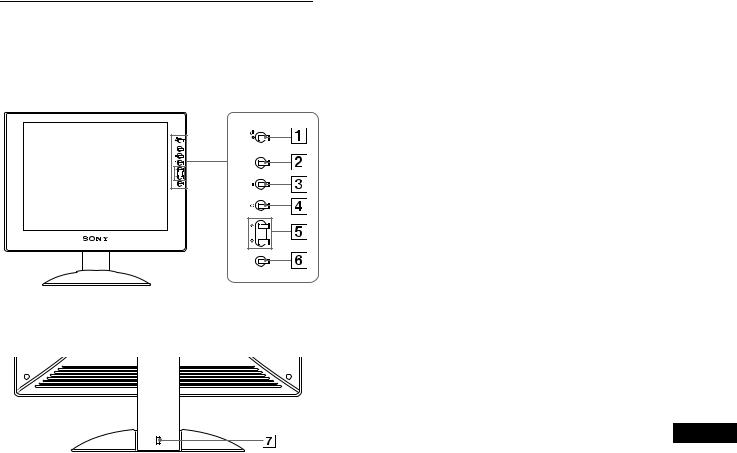
Identification des composants et des commandes
Pour plus de détails, reportez-vous aux pages entre parenthèses.
Avant de l’affichage à cristaux liquides
1Commutateur et indicateur 1 (alimentation)
(pages 9, 17, 21)
Ce commutateur sert à la mise sous et hors tension de l’écran. Le voyant d’alimentation s’allume en vert lorsque l’écran est mis sous tension et en orange lorsque le moniteur est en mode d’économie d’énergie.
MENU
MENU
OK
OK |
Arrière du support d’écran
OPEN
2Touche MENU (menu) (pages 11, 12)
Cette touche affiche ou ferme le menu principal.
3Touche 6 (contraste) (page 12)
Cette touche active l’affichage du menu CONTRASTE.
4Touche 8 (luminosité) (page 12)
Cette touche active l’affichage du menu LUMINOSITE.
5Touches M/m (page 12)
Ces touches fonctionnent comme les touches M/m lorsque vous sélectionnez des paramètres de menu et que vous effectuez des réglages.
6Touche OK (page 12)
Cette touche permet de sélectionner ou de valider des options dans le menu.
7 Trou de verrou de sécurit
Le verrou de sécurité doit être utilisé avec le système Kensington Micro Saver Security System.
Micro Saver Security System est une marque commerciale de
Kensington.
FR
(suite page suivante)
5

Arrière de l’affichage à cristaux liquides
OPEN
Ouvrez le capot arrière.
SDM-S51
SDM-S71/S81
9Connecteur DC IN (page 8)
Ce connecteur fournit une alimentation CC à l’écran. Raccordez l’adaptateur secteur à ce connecteur.
0Connecteur d’entrée HD15 (RVB) (page 7)
Ce connecteur entre les signaux vidéo RVB (0,7 Vp-p, positifs) et les signaux SYNC.
|
|
|
|
|
5 |
|
4 |
3 |
2 |
1 |
|
|
|
|
|
10 |
9 |
8 |
7 |
6 |
|
|
|
|
|
|
15 |
14 |
13 12 |
11 |
||
|
|
|
|
|
|
|
|
|
|
|
|
|
|
|
Broche n° |
Signal |
|
|
|
|
|
|
|
|
|
|
|
|
|
|||
1 |
Rouge |
|
|
|
|
|
||||
|
|
|
|
|
|
|
|
|||
2 |
Vert |
|
|
|
|
|
||||
|
|
|
|
|
(Synchronisation sur le vert) |
|||||
|
|
|
|
|
|
|
|
|||
3 |
Bleu |
|
|
|
|
|
||||
|
|
|
|
|
|
|
|
|||
4 |
ID (masse) |
|
|
|
|
|
||||
|
|
|
|
|
|
|
|
|||
|
|
5 |
Masse DDC* |
|
|
|
||||
|
|
|
|
|
||||||
|
|
|
|
|
||||||
6 |
Masse du rouge |
|
|
|||||||
|
|
|
|
|
|
|||||
7 |
Masse du vert |
|
|
|
||||||
|
|
|
|
|
|
|||||
|
|
|
8 |
Masse du bleu |
|
|
|
|||
|
|
|
9 |
DDC + 5V* |
|
|
|
|
||
|
|
|
|
|
|
|
||||
|
|
|
|
|
|
|
|
|||
10 |
Masse |
|
|
|
|
|
||||
|
|
|
|
|
|
|
|
|||
11 |
ID (masse) |
|
|
|
|
|
||||
|
|
|
||||||||
12 |
Données bidirectionnelles (SDA)* |
|||||||||
|
|
|
|
|
||||||
13 |
Synchronisation H |
|
|
|||||||
|
|
|
|
|
||||||
14 |
Synchronisation V |
|
|
|||||||
|
|
|
||||||||
15 |
Horloge de données (SCL)* |
|||||||||
|
|
|
|
|
|
|
|
|
|
|
|
|
|
|
|
|
|
|
|
|
|
* DDC (Display Data Channel) est une norme de VESA.
qa Maintien du câble (page 8)
Cette pièce permet de maintenir les câbles et les cordons à l’appareil.
8Capot arrière (page 8)
Ouvrez ce capot lorsque vous branchez ou débranchez des câbles ou des cordons.
6

Installation
Avant d’utiliser votre moniteur, vérifiez si les accessoires suivants se trouvent bien dans le carton d’emballage:
•Ecran LCD
•Câble d’alimentation
•Adaptateur secteur
•Câble de signal vidéo HD15 (RVB)
•Attache de cordon
•Windows Monitor Information/Windows Utility/Macintosh Utility Disk
•Carte de garantie
•Ce mode d’emploi
Etape 1 : Raccordez l’écran à votre ordinateur
Mettez l’appareil et l’ordinateur hors tension avant de procéder au raccordement.
Remarques
•Ne touchez pas les broches du connecteur du câble de signal vidéo, car vous risquez sinon de plier les broches.
•Vérifiez l’alignement du connecteur HD15 pour ne pas tordre les broches du connecteur du câble de signal vidéo.
xRaccordement à un ordinateur IBM PC/AT ou compatible
vers la sortie vidéo

 Câble de signal vidéo Ordinateur IBM PC/AT HD15 (RVB) (fourni) ou compatible
Câble de signal vidéo Ordinateur IBM PC/AT HD15 (RVB) (fourni) ou compatible
x Raccordement à un ordinateur Macintosh ou compatible
Lorsque vous raccordez ce moniteur à un ordinateur Macintosh, utilisez l’adaptateur Macintosh (non fourni), le cas échéant. Raccordez l’adaptateur Macintosh à l’ordinateur avant de brancher le câble.



 Câble de signal vidéo vers la sortie vidéo HD15 (RVB) (fourni)
Câble de signal vidéo vers la sortie vidéo HD15 (RVB) (fourni)
Ordinateur Macintosh ou compatible
FR
(suite page suivante)
7

Etape 2 : Branchez le câble d’alimentation
Après avoir mis l’appareil et l’ordinateur hors tension, connectez d’abord l’adaptateur secteur et le cordon d’alimentation au moteur de médias, puis connectez celui-ci à une prise électrique.
vers DC IN
OPEN
vers une prise secteur
Câble d’alimentation (fourni)
Adaptateur secteur (fourni)
Cette illustration est celle de la face arrière du moniteur SDM-S51.
Il en est de même pour le modèle SDM-S71/S81.
Etape 3 : Vérifiez que tous les câbles et cordons sont bien raccordés et refermez le capot arrière
1 Retirez le maintien de câble.
Maintien du câble
Les illustrations de l’arrière du moniteur représentent le modèle SDM-S51.
Il en est de même pour le modèle SDM-S71/S81.
2Maintenez tous les câbles et cordons en place avec ce maintien.
Regroupez les câbles et les cordons en faisceau, comme illustré, pour fermer le capot arrière correctement.
Maintien du câble
3 Refermez le capot arrière.
Regroupez les câbles et les cordons
Vous pouvez regrouper les câbles et les cordons en utilisant l’attache de cordon fournie.
Attache de cordon
8

Etape 4 : Mettez le moniteur et l’ordinateur sous tension
1Appuyez sur le commutateur 1 (alimentation).
Les indicateurs de l’appareil s’allument en vert.
2 Mettez l’ordinateur sous tension.
L’installation de votre moniteur est à présent terminée. Si nécessaire, utilisez les commandes du moniteur pour régler l’image.
Si aucune image n’apparaît sur l’écran
•Vérifiez que le câble d’alimentation et le câble du signal vidéo sont correctement raccordés.
•Si l’ndication PAS ENTREE VIDEO apparaît sur l’écran, l’ordinateur est en mode d’économie d’énergie. Essayez d’appuyer sur n’importe quelle touche du clavier ou de déplacer la souris.
•Si CABLE DECONNECT apparaît sur l’écran, vérifiez que le câble d’entrée vidéo est branché correctement.
•Si l’indication HORS PLAGE DE BALAYAGE apparaît sur l’écran, reconnectez l’ancien moniteur. Réglez ensuite la carte graphique de l’ordinateur de façon à ce que la fréquence horizontale soit comprise entre 28 – 60 kHz (SDM-S51), 28 – 92 kHz (SDM-S71/S81), et la fréquence verticale entre 48 – 75 Hz (SDM-S51), 48 – 85 Hz (SDM-S71/S81).
Pour des informations plus détaillées sur les messages à l’écran, voir “Symptômes de défaillances et remèdes” à la page 19.
FR
Vous n’avez besoin d’aucun pilote pour ce moniteur
Le moniteur prend en charge la fonction Plug & Play “DDC” et détecte automatiquement toutes les autres informations relatives au moniteur. Il n’est pas nécessaire d’installer de pilote pour cet ordinateur.
La première fois que vous mettez sous tension votre ordinateur après avoir raccordé le moniteur, l’assistant de réglage peut s’afficher sur l’écran. Dans ce cas, suivez les instructions indiquées sur l’écran. Le moniteur Plug & Play est automatiquement sélectionné afin que vous puissiez l’utiliser.
La fréquence verticale devient 60 Hz.
Etant donné que les scintillements sur le moniteur sont discrets, vous pouvez l’utiliser tel quel. Vous n’avez pas besoin de régler la fréquence verticale sur une valeur particulièrement élevée.
Si votre ordinateur ou votre carte graphique rencontre des difficultés de communication avec ce moniteur, installez le fichier d’informations de ce moniteur à l’aide de Windows Monitor Information Disk. Pour obtenir de plus amples informations sur l’installation, consultez le fichier ReadMe sur le disque.
9

Réglage de l’inclinaison
Cet écran peut être ajusté selon les angles illustrés ci-dessous.
30° 5°
Saisissez les côtés inférieurs de l’écran à cristaux liquides, puis ajustez l’inclinaison de l’écran.
Pour utiliser l’écran confortablement
Cet écran est conçu de manière à ce que vous puissiez le régler suivant un angle de visualisation confortable. Ajustez l’angle de visualisation de votre écran en fonction de la hauteur du bureau et de votre chaise et de manière à ce que l’écran ne vous réfléchisse pas la lumière dans les yeux.
10
